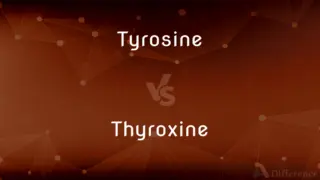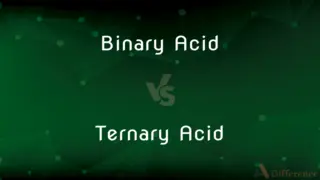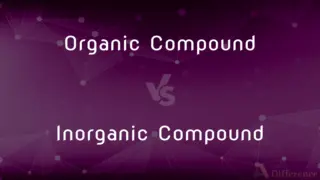Deamination vs. Deamidation — What's the Difference?
By Tayyaba Rehman & Fiza Rafique — Updated on May 5, 2024
Deamination is the removal of an amine group from a molecule, crucial in amino acid catabolism, while deamidation involves removing an amide group, impacting protein stability.

Difference Between Deamination and Deamidation
Table of Contents
ADVERTISEMENT
Key Differences
Deamination is a biochemical process where an amine group is removed from amino acids, typically resulting in the production of ammonia and a keto acid, which is important in the metabolism and excretion of nitrogen; deamidation, however, specifically involves the removal of an amide group from glutamine or asparagine within proteins, leading to the conversion into glutamic acid or aspartic acid.
Deamination is a key metabolic pathway in the liver that helps in detoxifying ammonia into urea for excretion, whereas deamidation often occurs in proteins and can affect protein stability, function, or aging.
During deamination, enzymes such as deaminases catalyze the reaction, playing a critical role in the urea cycle and nitrogen balance, while deamidation may occur non-enzymatically, often influenced by factors like pH and temperature.
Deamination can have broad implications in energy production and metabolic regulation; on the other hand, deamidation can impact the structural and functional integrity of proteins, affecting biological processes and pharmaceutical properties.
Deamination reactions are vital for the proper disposal of excess nitrogen in the body, while deamidation can lead to changes in protein properties that may be detrimental or beneficial, depending on the context.
ADVERTISEMENT
Comparison Chart
Process
Removal of an amine group (NH2)
Removal of an amide group (CONH2)
Occurrence
In amino acids during metabolism
In proteins, particularly at glutamine or asparagine
Products
Ammonia, keto acid
Glutamic acid, aspartic acid
Enzymatic Influence
Catalyzed by deaminases
Often non-enzymatic, influenced by environmental conditions
Biological Role
Vital in nitrogen excretion and urea cycle
Affects protein stability and function
Impact
Essential for energy production and metabolic balance
Influences protein aging and pharmaceutical properties
Compare with Definitions
Deamination
Biochemical removal of an amine group.
Deamination of amino acids in the liver produces urea.
Deamidation
Occurs in protein molecules.
Deamidation affects proteins like antibodies during aging.
Deamination
Linked to the urea cycle.
The urea cycle utilizes compounds formed during deamination.
Deamidation
Affects protein stability.
Deamidation can reduce the effective lifespan of therapeutic proteins.
Deamination
Results in ammonia production.
Ammonia released by deamination is converted to urea for excretion.
Deamidation
Biochemical removal of an amide group.
Protein deamidation leads to structural changes.
Deamination
Involves enzyme deaminases.
Deaminases facilitate the deamination process in various tissues.
Deamidation
Can be non-enzymatic.
Deamidation can occur spontaneously under certain pH conditions.
Deamination
Process in nitrogen metabolism.
Deamination is crucial for converting excess amino acids into usable forms.
Deamidation
Leads to aspartic or glutamic acids.
Asparagine deamidates to aspartic acid in some proteins.
Deamination
(organic chemistry) The removal of an amino group from a compound.
Deamidation
Deamidation is a chemical reaction in which an amide functional group in the side chain of the amino acids asparagine or glutamine is removed or converted to another functional group. Typically, asparagine is converted to aspartic acid or isoaspartic acid.
Deamination
Deamination is the removal of an amino group from a molecule. Enzymes that catalyse this reaction are called deaminases.
Deamidation
(biochemistry) The conversion of glutamine, asparagine, glutamine residues in a polypeptide to glutamic acid or aspartic acid by treatment with strong acid, transamidase or deamidase.
Deamination
To remove an amino group, NH2, from (an organic compound).
Deamidation
(organic chemistry) Conversion of an amide to a carboxylic acid.
Deamination
Removal of the amino radical from an amino acid or other amino compound
Common Curiosities
What factors influence the rate of deamidation in proteins?
Temperature, pH, and protein sequence influence the rate and occurrence of deamidation.
How does deamidation affect pharmaceuticals?
Deamidation can alter the stability and efficacy of protein-based drugs, impacting their shelf life and therapeutic properties.
Is deamination a reversible process?
Deamination is typically not reversible, as it involves the breakdown and removal of nitrogen waste.
Can deamidation be beneficial?
While often detrimental, deamidation can sometimes create protein forms with desired properties in industrial applications.
What enzymes are involved in deamidation?
Deamidation is often a non-enzymatic process, though specific deamidases exist in some organisms.
What triggers deamination in the body?
Deamination is triggered by the need to process and remove excess nitrogen from amino acids.
How do organisms handle excess ammonia from deamination?
Ammonia is converted into urea in the liver, which is then excreted via the kidneys.
What are the health implications of deamination?
Proper deamination is essential for detoxifying ammonia, with dysregulation potentially leading to conditions like hyperammonemia.
What role does deamination play in protein metabolism?
Deamination helps regulate amino acid levels and facilitates the use of amino acids for energy production.
Does deamidation occur in all proteins?
Not all proteins undergo deamidation; susceptibility depends on the protein structure and environmental conditions.
Share Your Discovery

Previous Comparison
Embroglio vs. Imbroglio
Next Comparison
Emitted vs. OmittedAuthor Spotlight
Written by
Tayyaba RehmanTayyaba Rehman is a distinguished writer, currently serving as a primary contributor to askdifference.com. As a researcher in semantics and etymology, Tayyaba's passion for the complexity of languages and their distinctions has found a perfect home on the platform. Tayyaba delves into the intricacies of language, distinguishing between commonly confused words and phrases, thereby providing clarity for readers worldwide.
Co-written by
Fiza RafiqueFiza Rafique is a skilled content writer at AskDifference.com, where she meticulously refines and enhances written pieces. Drawing from her vast editorial expertise, Fiza ensures clarity, accuracy, and precision in every article. Passionate about language, she continually seeks to elevate the quality of content for readers worldwide.
















































